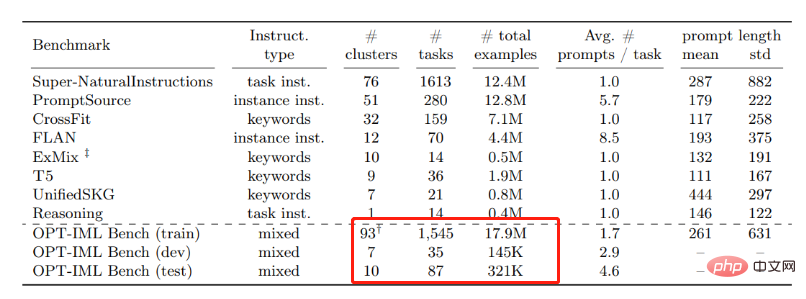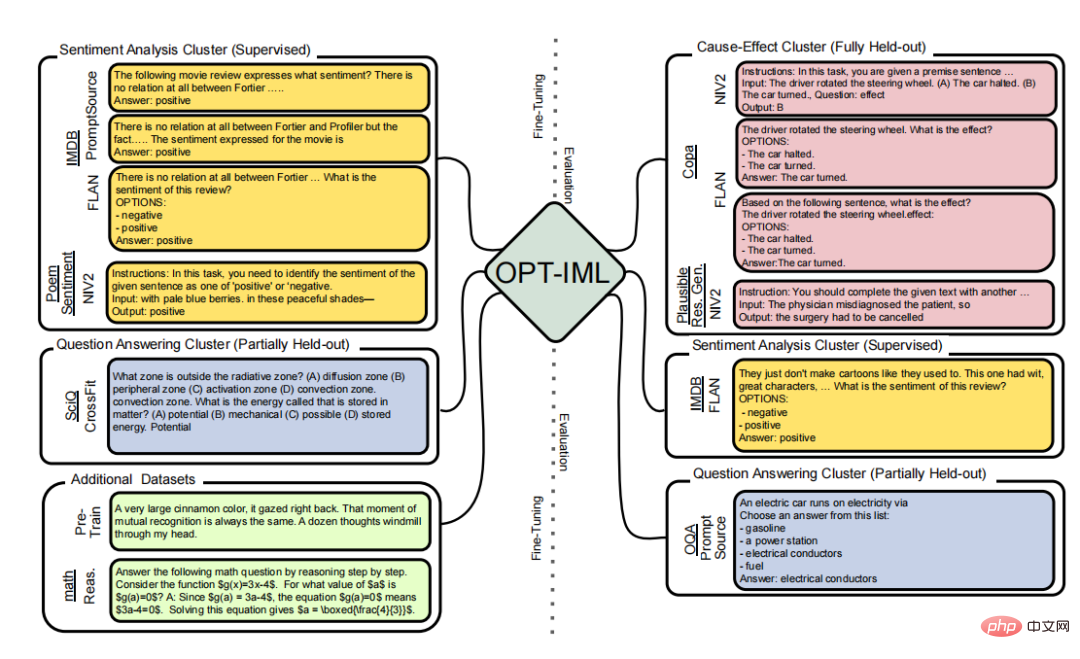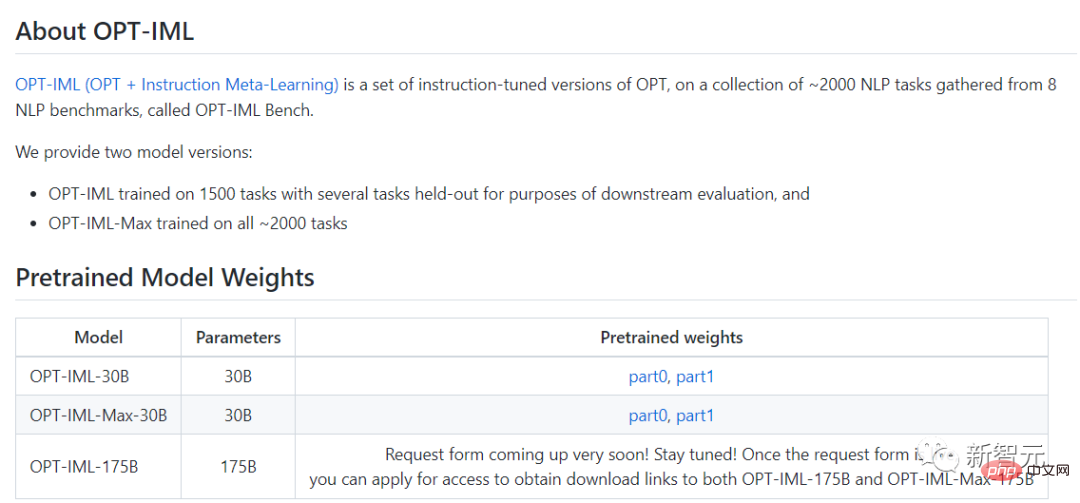 Technology peripherals
Technology peripherals
 AI
AI
 The 'upgraded version' of OPT-IML, Meta's large model with hundreds of billions of parameters, is here, and the complete model and code are released!
The 'upgraded version' of OPT-IML, Meta's large model with hundreds of billions of parameters, is here, and the complete model and code are released!
The 'upgraded version' of OPT-IML, Meta's large model with hundreds of billions of parameters, is here, and the complete model and code are released!
In May of this year, MetaAI officially announced the release of the ultra-large model OPT-175B based on 175 billion parameters, which is also open to all communities for free.
On December 22, an updated version of the model, OPT-IML (Open Pre-trained Transformer), was officially launched. Meta said it “fine-tuned 2,000 language tasks, including 1,750 Billions of Parameters" will also be freely available for non-commercial research purposes.

How about the performance of this updated OPT-IML? Let’s take a look at the two pictures.

This time OPT-IML created two model sizes, 30B and 175B.
Compared with the old OPT model, OPT-IML outperformed OPT on average in 14 standard NLP evaluation tasks.
The two model sizes are 7%~ better on the zero-shot learning task and 4%~ and 0.4%~ better on the 32-shot task.
In this study, researchers describe how increasing model and benchmark size affects the impact of instruction tuning decisions on downstream task performance.
To this end they developed OPT-IML Bench, a sizable instructional meta-learning (IML) benchmark containing 2000 NLP tasks based on eight existing Benchmarks are divided into task categories.

In order to train OPT-IML 30B and 175B, the researchers first proposed the instruction tuning decisions applied to OPT-30B from the perspective of this framework gained insights.
On four evaluation benchmarks (PromptSource, FLAN, Super-NaturalInstructions and UnifiedSKG) with different targets and input formats, OPT-IML demonstrates all three Generalization skills.
Not only does it significantly outperform OPT across all benchmarks, it also outperforms existing models optimized for this specific benchmark in a very competitive manner.
In addition, OPT-IML has been open sourced, and the editor has also put the Github link below~

Github link: https://github.com/facebookresearch/metaseq/tree/main/projects/OPT-IML
Let’s learn about it through the paper OPT-IML.

Paper link: https://github.com/facebookresearch/metaseq/blob/main/projects/OPT-IML/optimal_paper_v1 .pdf
Research Methods
Instructional fine-tuning of large language models has become an effective method to enhance their zero-shot and few-shot generalization capabilities. In this study, Meta researchers made three important additions to instruction fine-tuning.
First, they compiled a large-scale instruction fine-tuning benchmark containing 2,000 NLP tasks from eight dataset collections, categorized by task type.
Researchers selectively constructed evaluation splits on this benchmark to test three different types of model generalization capabilities:
Includes tasks from fully held-out categories, held-out tasks from seen types, and held-out instances from seen tasks (held- out instances from seen tasks).
Command fine-tuning
Fine-tune the model, To make them consistent with following instructions is one of the current research directions in machine learning.
There are two methods for instruction fine-tuning. One focuses on fine-tuning models for a variety of tasks using human-annotated instructions and feedback; the other, focuses on adding instructions via annotations or automatically to publicly accessible benchmarks and datasets.
In this study, Meta AI members focused on the second technique and compiled a number of publicly accessible datasets containing methods for improving OPT.
During the research, Meta members proposed a similar scaling method using 1836 tasks from four benchmarks. Finally, while tuning the entire test to push the performance limits of challenging external benchmarks such as MMLU and Big-Bench Hard (BBH), the researchers describe the weights of various instruction tuning strategies that may impact downstream performance.
Multi-task learning
Multi-task learning is a representation of instruction-based fine-tuning (MTL).
MTL is a popular paradigm that can improve task generalization performance when combined with similar functions that share comparable parameters or representations.
In recent years, MTL has been applied to numerous NLP scenarios, mainly focusing on improving the performance of training tasks or new domains by leveraging signals from related activities.
In contrast, instruction-based fine-tuning helps us improve generalization performance to never-before-seen problems. It does this by instructing to combine all tasks into a concept and train them together by assigning the weights of the model across all tasks.
What is OPT?
Large-scale language models, natural language processing systems with over 100 billion parameters, have transformed NLP and AI research over the past few years.
These models are trained on a vast array of diverse texts, demonstrating surprising new abilities to generate creative text, solve basic math problems, answer reading comprehension questions, and more.
While in some cases the public can interact with these models via paid APIs, full research access is still limited to a handful of well-resourced labs.
This restricted access limits researchers’ ability to understand how and why these large language models work, hindering progress in improving their robustness and mitigating known issues such as bias. .
Out of its commitment to open science, Meta AI released Open Pretrained Transformer (OPT-175B) in May this year, a model with 175 billion parameters, which can be used on public data. It is trained on the set. The reason for sharing this model is that Meta AI hopes that more communities will participate in understanding the basic technology about large models.
Simply put, Meta opens access to large-scale language models used in artificial intelligence research to the public, thereby realizing the democratization of artificial intelligence in large-scale model research.
Comparison with the old version
The IML version currently released by Meta has been fine-tuned and performs better on natural language tasks than the old version of OPT.
Typical language tasks include answering questions, summarizing text, and translating.
To fine-tune, the researchers used approximately 2,000 natural language tasks. The tasks are divided into eight NLP benchmarks (OPT-IML Bench), which are also provided by the researchers.
On average, taking the 30B and 175B models as examples, OPT-IML improves the zero-shot learning accuracy by about 6-7% compared to OPT. In 32 epochs of learning, the model with 30 billion parameters showed a significant improvement in accuracy, and the model with 175 billion parameters showed a slight improvement.

After comparison, the Meta team found that the performance of OPT-IML was better than OPT on all benchmark tests, and in terms of zero-shot and few-shot learning accuracy, it was better than other Models based on instruction fine-tuning are more competitive.
The above is the detailed content of The 'upgraded version' of OPT-IML, Meta's large model with hundreds of billions of parameters, is here, and the complete model and code are released!. For more information, please follow other related articles on the PHP Chinese website!

Hot AI Tools

Undresser.AI Undress
AI-powered app for creating realistic nude photos

AI Clothes Remover
Online AI tool for removing clothes from photos.

Undress AI Tool
Undress images for free

Clothoff.io
AI clothes remover

AI Hentai Generator
Generate AI Hentai for free.

Hot Article

Hot Tools

Notepad++7.3.1
Easy-to-use and free code editor

SublimeText3 Chinese version
Chinese version, very easy to use

Zend Studio 13.0.1
Powerful PHP integrated development environment

Dreamweaver CS6
Visual web development tools

SublimeText3 Mac version
God-level code editing software (SublimeText3)

Hot Topics
 1386
1386
 52
52
 The world's most powerful open source MoE model is here, with Chinese capabilities comparable to GPT-4, and the price is only nearly one percent of GPT-4-Turbo
May 07, 2024 pm 04:13 PM
The world's most powerful open source MoE model is here, with Chinese capabilities comparable to GPT-4, and the price is only nearly one percent of GPT-4-Turbo
May 07, 2024 pm 04:13 PM
Imagine an artificial intelligence model that not only has the ability to surpass traditional computing, but also achieves more efficient performance at a lower cost. This is not science fiction, DeepSeek-V2[1], the world’s most powerful open source MoE model is here. DeepSeek-V2 is a powerful mixture of experts (MoE) language model with the characteristics of economical training and efficient inference. It consists of 236B parameters, 21B of which are used to activate each marker. Compared with DeepSeek67B, DeepSeek-V2 has stronger performance, while saving 42.5% of training costs, reducing KV cache by 93.3%, and increasing the maximum generation throughput to 5.76 times. DeepSeek is a company exploring general artificial intelligence
 AI subverts mathematical research! Fields Medal winner and Chinese-American mathematician led 11 top-ranked papers | Liked by Terence Tao
Apr 09, 2024 am 11:52 AM
AI subverts mathematical research! Fields Medal winner and Chinese-American mathematician led 11 top-ranked papers | Liked by Terence Tao
Apr 09, 2024 am 11:52 AM
AI is indeed changing mathematics. Recently, Tao Zhexuan, who has been paying close attention to this issue, forwarded the latest issue of "Bulletin of the American Mathematical Society" (Bulletin of the American Mathematical Society). Focusing on the topic "Will machines change mathematics?", many mathematicians expressed their opinions. The whole process was full of sparks, hardcore and exciting. The author has a strong lineup, including Fields Medal winner Akshay Venkatesh, Chinese mathematician Zheng Lejun, NYU computer scientist Ernest Davis and many other well-known scholars in the industry. The world of AI has changed dramatically. You know, many of these articles were submitted a year ago.
 Google is ecstatic: JAX performance surpasses Pytorch and TensorFlow! It may become the fastest choice for GPU inference training
Apr 01, 2024 pm 07:46 PM
Google is ecstatic: JAX performance surpasses Pytorch and TensorFlow! It may become the fastest choice for GPU inference training
Apr 01, 2024 pm 07:46 PM
The performance of JAX, promoted by Google, has surpassed that of Pytorch and TensorFlow in recent benchmark tests, ranking first in 7 indicators. And the test was not done on the TPU with the best JAX performance. Although among developers, Pytorch is still more popular than Tensorflow. But in the future, perhaps more large models will be trained and run based on the JAX platform. Models Recently, the Keras team benchmarked three backends (TensorFlow, JAX, PyTorch) with the native PyTorch implementation and Keras2 with TensorFlow. First, they select a set of mainstream
 Hello, electric Atlas! Boston Dynamics robot comes back to life, 180-degree weird moves scare Musk
Apr 18, 2024 pm 07:58 PM
Hello, electric Atlas! Boston Dynamics robot comes back to life, 180-degree weird moves scare Musk
Apr 18, 2024 pm 07:58 PM
Boston Dynamics Atlas officially enters the era of electric robots! Yesterday, the hydraulic Atlas just "tearfully" withdrew from the stage of history. Today, Boston Dynamics announced that the electric Atlas is on the job. It seems that in the field of commercial humanoid robots, Boston Dynamics is determined to compete with Tesla. After the new video was released, it had already been viewed by more than one million people in just ten hours. The old people leave and new roles appear. This is a historical necessity. There is no doubt that this year is the explosive year of humanoid robots. Netizens commented: The advancement of robots has made this year's opening ceremony look like a human, and the degree of freedom is far greater than that of humans. But is this really not a horror movie? At the beginning of the video, Atlas is lying calmly on the ground, seemingly on his back. What follows is jaw-dropping
 KAN, which replaces MLP, has been extended to convolution by open source projects
Jun 01, 2024 pm 10:03 PM
KAN, which replaces MLP, has been extended to convolution by open source projects
Jun 01, 2024 pm 10:03 PM
Earlier this month, researchers from MIT and other institutions proposed a very promising alternative to MLP - KAN. KAN outperforms MLP in terms of accuracy and interpretability. And it can outperform MLP running with a larger number of parameters with a very small number of parameters. For example, the authors stated that they used KAN to reproduce DeepMind's results with a smaller network and a higher degree of automation. Specifically, DeepMind's MLP has about 300,000 parameters, while KAN only has about 200 parameters. KAN has a strong mathematical foundation like MLP. MLP is based on the universal approximation theorem, while KAN is based on the Kolmogorov-Arnold representation theorem. As shown in the figure below, KAN has
 Tutorial on how to solve the problem of being unable to access the Internet after upgrading win10 system
Mar 27, 2024 pm 02:26 PM
Tutorial on how to solve the problem of being unable to access the Internet after upgrading win10 system
Mar 27, 2024 pm 02:26 PM
1. Use the win+x shortcut key to open the menu and select [Command Prompt (Administrator) (A)], as shown below: 2. After entering the command prompt interface, enter the [ipconfig/flushdns] command and press Enter , as shown in the figure below: 3. Then enter the [netshwinsockresetcatalog] command and press Enter, as shown in the figure below: 4. Finally enter the [netshintipreset] command and press Enter, restart the computer and you can access the Internet, as shown in the figure below:
 Tesla robots work in factories, Musk: The degree of freedom of hands will reach 22 this year!
May 06, 2024 pm 04:13 PM
Tesla robots work in factories, Musk: The degree of freedom of hands will reach 22 this year!
May 06, 2024 pm 04:13 PM
The latest video of Tesla's robot Optimus is released, and it can already work in the factory. At normal speed, it sorts batteries (Tesla's 4680 batteries) like this: The official also released what it looks like at 20x speed - on a small "workstation", picking and picking and picking: This time it is released One of the highlights of the video is that Optimus completes this work in the factory, completely autonomously, without human intervention throughout the process. And from the perspective of Optimus, it can also pick up and place the crooked battery, focusing on automatic error correction: Regarding Optimus's hand, NVIDIA scientist Jim Fan gave a high evaluation: Optimus's hand is the world's five-fingered robot. One of the most dexterous. Its hands are not only tactile
 FisheyeDetNet: the first target detection algorithm based on fisheye camera
Apr 26, 2024 am 11:37 AM
FisheyeDetNet: the first target detection algorithm based on fisheye camera
Apr 26, 2024 am 11:37 AM
Target detection is a relatively mature problem in autonomous driving systems, among which pedestrian detection is one of the earliest algorithms to be deployed. Very comprehensive research has been carried out in most papers. However, distance perception using fisheye cameras for surround view is relatively less studied. Due to large radial distortion, standard bounding box representation is difficult to implement in fisheye cameras. To alleviate the above description, we explore extended bounding box, ellipse, and general polygon designs into polar/angular representations and define an instance segmentation mIOU metric to analyze these representations. The proposed model fisheyeDetNet with polygonal shape outperforms other models and simultaneously achieves 49.5% mAP on the Valeo fisheye camera dataset for autonomous driving



